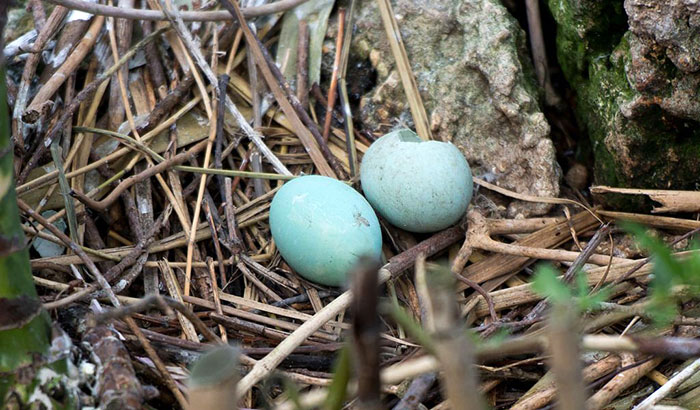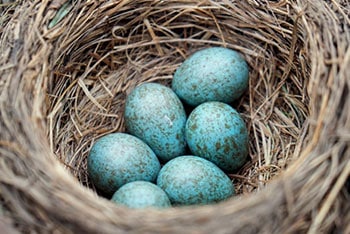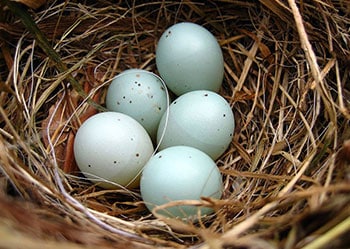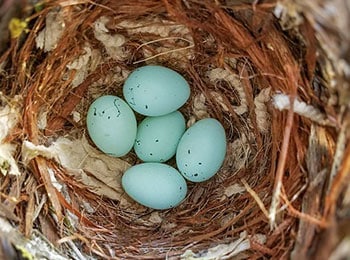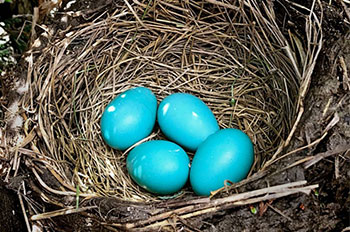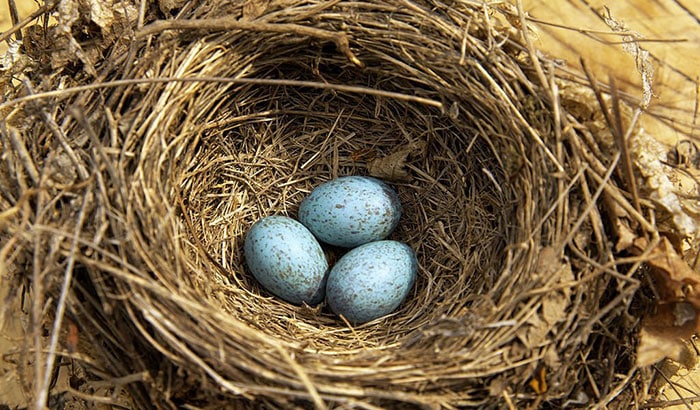So, you are walking in the park and at the side of the trail, you spot a bird’s nest. Upon inspecting it closer, you find that the eggs have unusual colors – they are blue. You then ask yourself what birds lay blue eggs?
You are so used to seeing white and brown eggs, so finding one that seems unnaturally colored is surprising. If you are not a birdwatcher, then you will be even more flabbergasted to know that there are quite a lot of birds that lay blue eggs, and many other colors.
Read on to learn what types of birds lay blue eggs. Also, you will be learning why these bird eggs are the color that they are.
Contents
What Bird Species Lay Blue Eggs?
So, what kind of bird lays blue eggs? Most people probably already know that robins lay blue eggs. But what they also probably do not know is that there are lots of other bird species that lay blue or bluish-green eggs. Here are some of them:
Common Blackbird
The common blackbird commonly lives in wooded areas, like parks, farmland hedges, gardens, and the like. You might even find these tiny little rascals feeding in your lawn or garden during the spring and summer.
These birds have a caroling song commonly heard in both urban and suburban areas, a testament to their amazing adaptability. The common blackbird lays its clutch of 3 to 5 blue eggs usually between March and July. The eggs are bluish-green with red specks sprinkled all over, and their average size is 29mm long and 22mm wide.
Dunnock
You can usually find dunnocks in the outskirts of forests, hedgerows, gardens, and parks. Many often mistake these birds for the common house sparrow. The dunnock is a small bird that usually feeds on insects, earthworms, and seeds.
Male and female dunnocks typically mate for life. However, there are times when the female would mate with other male dunnocks. This tiny bird can lay up to 5 eggs per laying season.
The female dunnock can lay a clutch consisting of 4 to 5 tiny eggs at a time. The eggs have a glossy blue color with faint reddish-brown specks, and they are, on average, 19mm long and 14mm wide.
House Finches
House finches are dull brown. They also have long, brown, square-tipped tails, and gray wings. Their flanks usually have streaks. The female house finch has a streaked underbelly.
These birds will usually lay 4 to 5 eggs during the summer. If you are interested in keeping them in your garden, they do like using nest boxes. The house finch lays eggs that have a pale blue (almost white) color with some black specks.
Song Thrush
The song thrush is a small bird that has a brown plumage and a white underbelly covered with droplet-shaped brown spots. You can often find this small songbird in wooded habitats, including city parks, tree hedges in farmlands, and gardens. These birds usually feed on seeds and insects.
On average, an adult Song Thrush can lay up to 5 eggs at a time. The eggs have a glossy and light-blue color. Black or purple specks also cover them. Song thrush eggs are also quite small, measuring 27mm long and 21mm wide. Just like the other birds on this list, the song thrush usually lays eggs during the summer.
What Other Colors Can Birds’ Eggs Come In?
While most bird eggs are white, they also come in many other different colors. As mentioned above, there are lots of birds that lay blue eggs, and they come in various shades.
Some birds lay eggs that are aquamarine, olive green, brown, reddish-brown, and a whole lot more. Also, some eggs are glossy and have a solid color throughout. Others have mottled specks that cover the entire surface of the egg.
Aside from colors, bird eggs also have different spots and patterns. Robin eggs are usually just a solid bright blue while other birds have eggs that are the same color but with brown specks all over. There are even some eggs with similar color patterns that resemble marble tiles.
Why Do Bird Eggs Have Different Colors?
Aside from helping the developing bird embryo, eggs are also nutritious snacks for other animals, including other birds. This is the reason why eggs are colored the way they are – for extra protection. Bird eggs come in different colors because they evolved a natural camouflage. Their colors also depend on where the birds live.
The parents are not always in their nest, so sometimes, they need to leave their eggs unguarded. Snakes, lizards, and other birds actively hunt for bird eggs because they are highly nutritious. They do not also fight back, making them easy targets.
However, because of their natural camouflage, predators will need to work a bit harder to spot the defenseless little eggs.
Aside from camouflage, the colors of the bird eggs also protect them against the harmful rays of the sun. The heat and radiation from the rays of the sun can cause significant damage to the contents of the egg. They can also affect the incubation period of the bird embryo.
If the heat from the sun “rushes” the incubation period, it will adversely affect the development of the unhatched chick. This can cause untoward mutations. The heat from the sun can easily overheat dark-colored eggs compared to lighter-colored ones.
This is the reason why birds who lay their eggs in the open, like eagles and hawks, have white shells. Their daily diet consists of small animals, and they would even eat the bones. The extra calcium turns the eggs white. On the other hand, smaller birds that need to hide their eggs have dark-colored eggs as they help camouflage them.
Conclusion
Blue-colored bird eggs might seem strange for the uninitiated but it is quite a common color for those who have been on the birdwatching trail. From protecting the eggs from egg-eating predators to protecting their contents from the rays of the sun, the blue coloration of the eggs plays an important role in their survival.
Now, you have most likely learned about other birds aside from the common American red-breasted robin. You have also learned what birds lay blue eggs, so you might want to start becoming a birdwatcher. The next time you find blue eggs on your next nature hike, try to identify which bird species they came from.

